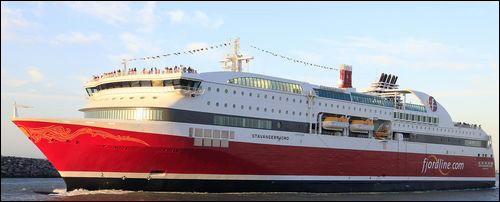Norwegian ship operator Fjord Line is employing radio frequency identification technology to manage ticketing and cabin access on one of its ferries, and plans to extend the technology’s use to the identification and confirmation of passengers’ onboard services, such as at restaurants. The RFID-enabled ticketing and access system, provided by passenger-ship IT solution company Carus, includes passive high-frequency (HF) 13.56 MHz RFID tags, compliant with the ISO 14443 standard, embedded in paper tickets carried by passengers, as well as handheld readers used by staff members at the ferry’s entrance, and RFID-enabled door locks for all of the ship’s 300 cabins.
In July 2013, Fjord Line installed the solution on the company’s newest ferry as it was put into commission—the MS Stavangerfjord, which travels between Norway and Denmark—while a second new ferry is now being equipped with the technology as well, with plans for the solution to be taken live in April 2014. Fjord Line provides transportation for both tourists and commuters. The Stavangerfjord—which travels between Bergen, Stavanger and Langesund in Norway, as well as Hirtshals, Denmark—has a capacity of 1,500 passengers and 600 vehicles, with 306 cabins and five restaurants or bars.
Carus has provided a reservation and ticketing system to Fjord Line for all of its ferries since 2001, says Anders Rundberg, Carus’ CEO. The Carus system manages payments, the printing of tickets and the booking of reservations. On Fjord Line’s two older ferries, the MS Bergensfjord and the Fjord Line Express, passengers use a bar-coded paper ticket for boarding and a separate magnetic-stripe card for bunk access. Each guest presents the bar-coded ticket to personnel at the gangway, and the ticket is read by a bar-code scanner and then returned to that individual. This process enables the ferry to create a record of all tickets received before the ferry left the dock. Each passenger uses a separate magnetic-stripe bunk card to gain entrance to a particular cabin (the journey can last for several days, so those onboard overnight would need to reserve a bed). Up to four beds are installed within each cabin; therefore, multiple passengers share a cabin (most often in groups of four, such as families).
This system of bar codes and mag stripes works fine, says Linda Selle, Fjord Line’s IT manager. However, RFID offered several benefits. For example, with RFID, a greater amount of data could be linked to a ticket-holder, thereby enabling a staff member equipped with a handheld reader loaded with the software to ensure that the ticket was correct (for example, the proper ticket for that specific date). The mag-stripe readers at the cabin door locks require a great deal of maintenance, she adds.
However, Selle says, the benefits of RFID will not be fully realized until the cruise ship line moves into phase two of the installation. During the next few years, the company hopes to use the RFID tickets to validate prepaid services for passengers. For example, if passenger traveler prepays for breakfast, Internet access, cocktails or some other services, that information would be stored in Carus’ CarRes ticketing software, and could then be accessed via RFID readers when that individual presents the ticket to the staff. When ordering breakfast, for instance, the passenger would simply present his or her RFID-enabled ticket. A worker would read the RFID tag’s ID number, and the software would indicate if the breakfast was paid for, as well as create an electronic record indicating that the meal had been redeemed. Currently, passengers receive vouchers that they must present to the crew as they receive services previously paid for.
At present, however, the RFID system’s benefits are simple, Selle says. Passengers no longer require both a bunk card and a ticket; instead, each traveler is issued a single paper card containing an embedded HF RFID inlay made with an NXP Semiconductors Mifare 1K chip. First, Rundberg explains, the passenger books a ticket and reserves a cabin bed. Upon arriving, he or she receives the RFID-enabled card, printed by Fjord on a Boca Systems RFID ticket printer. When the guest boards the ferry, the unique ID number encoded to the card’s RFID tag is read using a Motorola Solutions MC75A HF RFID mobile computer. The device can either store the read data and upload that ticketing boarding information when it comes within range of a Wi-Fi connection, or transmit the data immediately via Wi-Fi. In either case, the firmware on the handheld identifies each ID number, links that ID to the reservation records for that particular voyage and displays an alert in the event that an unauthorized ticket is being used.
The passenger then takes the ticket to his or her cabin door and taps it near the RFID-enabled door lock, provided by VingCard Marine. The lock’s reader captures the ID number, confirms that it is correct and, if so, unlatches the door.
Since the system’s installation about 10 weeks ago, Selle reports, she has not yet collected any data regarding the benefits achieved from the technology’s use. She says she believes the bar-code check-in process was slightly faster than the RFID-enabled version. However, because the RFID system can store a greater amount of ticket data, such as a passenger’s identity and ticket type, it provides better information to ensure accurate boarding processes. What’s more, Rundberg notes, the use of RFID “gives a better security than the mag stripe and the bar code, which can be written in several identical copies [cloned].”
The greatest benefit, according to Selle, will be derived during phase two, when the services are linked to an individual’s ticket ID on the CarRes software. That, she says, will eliminate the need for vouchers, and make processes more efficient for passengers.



